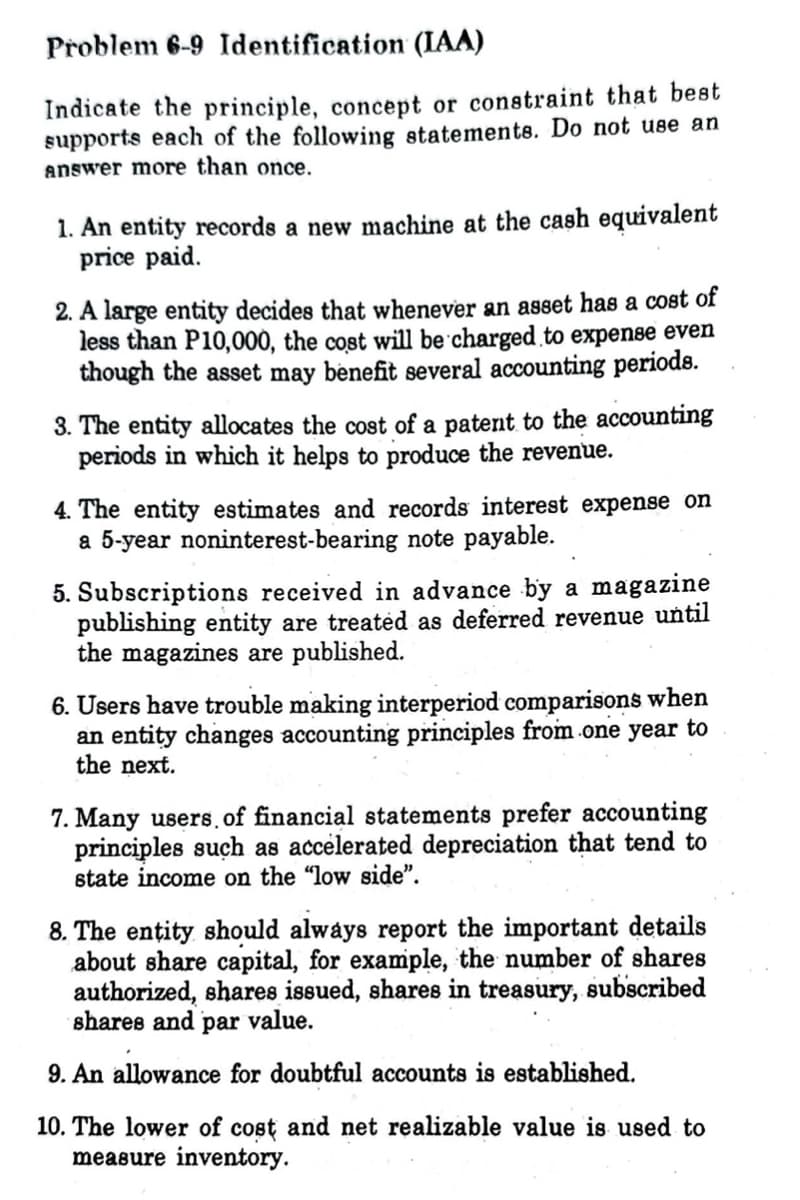Indicate the principle, concept or constraint that best supports each of the following statements. Do not use an answer more than once. 1. An entity records a new machine at the cash equivalent price paid. 2. A large entity decides that whenever an asset has a cost of less than P10,000, the cost will be charged to expense even though the asset may benefit several accounting periods. 3. The entity allocates the cost of a patent to the accounting periods in which it helps to produce the revenue. 4. The entity estimates and records interest expense on a 5-year noninterest-bearing note payable. 5. Subscriptions received in advance by a magazine publishing entity are treated as deferred revenue until the magazines are published. 6. Users have trouble making interperiod comparisons when an entity changes accounting principles from one year to the next. 7. Many users, of financial statements prefer accounting principles such as accelerated depreciation that tend to state income on the "low side". 8. The entity should always report the important details about share capital, for example, the number of shares authorized, shares issued, shares in treasury, subscribed shares and par value. 9. An allowance for doubtful accounts is established. 10. The lower of cost and net realizable value is used to measure inventory.
Indicate the principle, concept or constraint that best supports each of the following statements. Do not use an answer more than once. 1. An entity records a new machine at the cash equivalent price paid. 2. A large entity decides that whenever an asset has a cost of less than P10,000, the cost will be charged to expense even though the asset may benefit several accounting periods. 3. The entity allocates the cost of a patent to the accounting periods in which it helps to produce the revenue. 4. The entity estimates and records interest expense on a 5-year noninterest-bearing note payable. 5. Subscriptions received in advance by a magazine publishing entity are treated as deferred revenue until the magazines are published. 6. Users have trouble making interperiod comparisons when an entity changes accounting principles from one year to the next. 7. Many users, of financial statements prefer accounting principles such as accelerated depreciation that tend to state income on the "low side". 8. The entity should always report the important details about share capital, for example, the number of shares authorized, shares issued, shares in treasury, subscribed shares and par value. 9. An allowance for doubtful accounts is established. 10. The lower of cost and net realizable value is used to measure inventory.
Cornerstones of Financial Accounting
4th Edition
ISBN:9781337690881
Author:Jay Rich, Jeff Jones
Publisher:Jay Rich, Jeff Jones
Chapter2: The Accounting Information System
Section: Chapter Questions
Problem 62BPSB: Problem 2-62B Comprehensive Problem Mulberry Services sells electronic data processing services to...
Related questions
Question
Kindly answer numbers 1-10.

Transcribed Image Text:Problem 6-9 Identification (IAA)
Indicate the principle, concept or constraint that best
supports each of the following statements. Do not use an
answer more than once.
1. An entity records a new machine at the cash equivalent
price paid.
2. A large entity decides that whenever an asset has a cost of
less than P10,000, the cost will be charged to expense even
though the asset may benefit several accounting periods.
3. The entity allocates the cost of a patent to the accounting
periods in which it helps to produce the revenue.
4. The entity estimates and records interest expense on
a 5-year noninterest-bearing note payable.
.
5. Subscriptions received in advance by a magazine
publishing entity are treated as deferred revenue until
the magazines are published.
6. Users have trouble making interperiod comparisons when
an entity changes accounting principles from one year to
the next.
7. Many users, of financial statements prefer accounting
principles such as accelerated depreciation that tend to
state income on the "low side".
8. The entity should always report the important details
about share capital, for example, the number of shares
authorized, shares issued, shares in treasury, subscribed
shares and par value.
9. An allowance for doubtful accounts is established.
10. The lower of cost and net realizable value is used to
measure inventory.
Expert Solution
This question has been solved!
Explore an expertly crafted, step-by-step solution for a thorough understanding of key concepts.
Step by step
Solved in 2 steps

Knowledge Booster
Learn more about
Need a deep-dive on the concept behind this application? Look no further. Learn more about this topic, accounting and related others by exploring similar questions and additional content below.Recommended textbooks for you

Cornerstones of Financial Accounting
Accounting
ISBN:
9781337690881
Author:
Jay Rich, Jeff Jones
Publisher:
Cengage Learning

Accounting (Text Only)
Accounting
ISBN:
9781285743615
Author:
Carl Warren, James M. Reeve, Jonathan Duchac
Publisher:
Cengage Learning

Cornerstones of Financial Accounting
Accounting
ISBN:
9781337690881
Author:
Jay Rich, Jeff Jones
Publisher:
Cengage Learning

Accounting (Text Only)
Accounting
ISBN:
9781285743615
Author:
Carl Warren, James M. Reeve, Jonathan Duchac
Publisher:
Cengage Learning